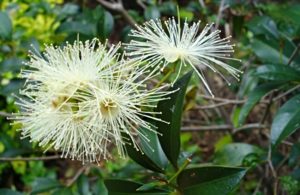The Melaleuca fulgens is a stunning, grey-green endemic shrub that is most often mistaken for a bottle brush species. Although not a true bottle brush, the Melaleuca fulgens plant produces mesmerising apricot coloured flower spikes, inviting it's more common name, apricot delight.
With showy flowers and a relatively easy-care routine, they’re a great choice for a variety of garden settings and landscapes. Here is everything you need to know to cultivate, care for and grow Melaleuca fulgens in your garden.
More...
Melaleuca fulgens Features
Family: Myrtaceae
Genus: Melaleuca
Species: M. fulgens
Common Name: Scarlet Honey Myrtle
Flower Colour: Orange
Foliage Colour: Green
Growth Habit: Shrub to 2m
Flowering: Spring

There are over 200 species of Melaleuca plants endemic to many regions of Western Australia. Bearing a striking similarity to bottle brushes, melaleuca plants are part of the Myrtaceae family and produce differently coloured flower spikes.
Melaleuca fulgens is considered a honey myrtle, a common species of smaller growing trees and shrubs found growing in South Australia, Victoria, Tasmania and south-eastern Australia. These plants are known to be incredibly hardy and easy to establish in a range of Australian landscapes.
Melaleuca fulgens or scarlet honey myrtle is best recognised by its tall, bushy growth habit, grey-green foliage and yellow-tipped flower spikes. These flower spikes inspired the name Fulgens, which means ‘bright in colour’ in Latin.
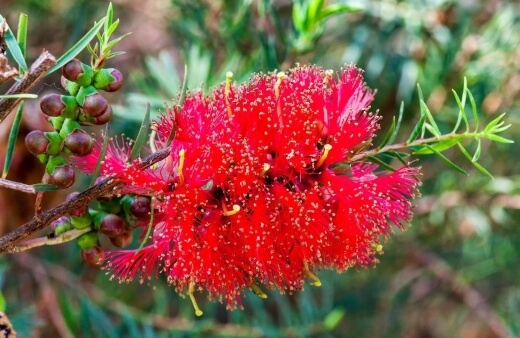
Also called the Scarlet Honey Myrtle, this species is prized for its easy-to-shape foliage and evergreen, slender branches.
The flower spikes, which bloom throughout the spring, summer and long into the winter, are known to be a valuable nectar source for bees and birds. Its leaves are also incredibly fragrant when bruised.
Suited to coastal regions and more humid environments, the Melaleuca fulgens can be grown almost anywhere in the garden, in a container or as a screen or windbreak.
Many gardeners also opt to use it as a feature plant, surrounded by smaller shrubs and flowering natives. If consistently pruned, it can also be a taller growing ground cover.
They are also known to be suitable for xeriscaping. The Melaleuca fulgens ‘Hot pink’ cultivar also offers an exciting alternative, with a distinctly similar growth habit but bright pink flower spikes.
How to Grow Melaleuca fulgens
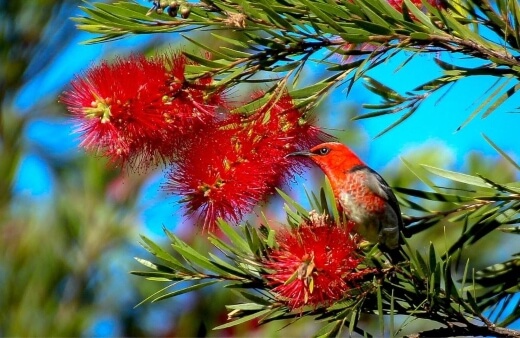
The scarlet honey myrtle is generally considered quite compact. Growing around 1.5 metres by 1.5 metres, they’re a great choice as a feature plant, screening plant or as part of a large raised bed or planter.
Don't miss our 10 Best Raised Garden Bed Reviews and Buying Guide.
These plants are very suited to growing in shaded and half-shaded areas. However, they bloom best when grown in full sun. Although they can grow in shaded areas, it is not advisable to grow this species indoors.
They really are better outdoor plants, and of course, a valuable source for local nectar feeders. Scarlet honey myrtle grows in most kinds of soil conditions, including moist, loam, gravel and clay soils.
Nonetheless, ensuring a mostly well-draining soil is essential as overly wet roots can quickly develop root rot and cause issues. Avoid growing these plants in limestone soils as they can develop certain issues.
These plants are not particularly pH sensitive. However, should you notice a yellowing of foliage, it could be due to a level of high alkalinity in the soil. Ideally, keep soils at a neutral P.H. level for ideal growth.
This species fares best when planted into soil that has cooled from the heat of the day but still holds some warmth. Most growers recommend growing in late autumn or early winter for the best results.
These plants are considered semi-fast growing plants, and in the right, outdoor conditions can grow to a height of 3 metres tall.
Propagating Melaleuca fulgens

Although these plants are most often bought, they are easily propagated from the readily available seeds. A soft-tip stem cutting can also be made.
Growing Melaleuca fulgens from Seeds
Seeds can be bought from local nurseries or taken from parent plants after the time of flowering. Seeds do not require any kind of pre-treatment before planting.
However, as with many other endemic species, it can take some time to germinate. Be patient, and avoid discarding seeds too early if you do not see results.
Here’s how to sow seeds:
- Seeds should be germinated at a temperature between 18°C and 22°C. Avoid sowing seeds during the hottest or coldest days of the year.
- Prepare a seedling tray or small container with a light, well-draining seeding mix.
- Sow seed directly onto the surface of the soil and press down gently. Do not bury seed under the soil.
- Keep the soil warm and moist during the time of germination.
- Germination takes around 14 to 28 days.
Growing Scarlet Honey Myrtle from Cuttings
Cuttings can be removed from healthy, thriving parent plants. It should be noted that bloom colour can sometimes vary depending on which species you are taking a cutting from.
- Remove a stem cutting, approximately 75-100mm in length.
- Remove any leaves along with the lower third of the cutting.
- Wound the lower stem with a grafting knife or scissors. This will help to encourage root growth.
- Dip the wounded end into a rooting hormone and plant into a rich, organic soil mixture.
Planting Scarlet Honey Myrtle
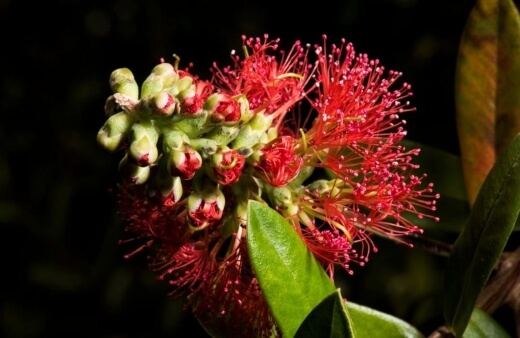
As with most other Melaleuca species, these plants require the most consideration when establishing. Once your seedling or cutting has produced new growth, or if buying an established plant from a native nursery – you can plant your Melaleuca fulgens during early autumn.
Simply:
- If growing in the ground, dig a hole twice the size of the root ball.
- If growing in a container, add potting mix until about 1/3 of the container is filled. (Get the best potting mix here.)
- Place the root ball and backfill with soil. Press down gently with your hands to remove any air pockets.
- Create a small ring or doughnut around the base of the stem; this will help you plant retain moisture.
- Keep the soil moist for the first few growing cycles.
While it is not necessary, adding a slow-release fertiliser to the soil at the time of planting can help to support the plant and encourage new growth. Any native fertiliser will be suitable for the scarlet honey myrtle.
Container grown plants can sometimes look leggy when first planting into soil. Don’t be dismayed; with some fertiliser and a good prune two months after planting, they tend to grow back with vigour.
How to Care for Melaleuca fulgens
The scarlet honey myrtle generally requires very little attention as opposed to other flowering plants. The only time they become finicky is in regions that experience extreme cold.
Normally these plants are very hardy. However, young stems can experience frost burn if temperatures drop too quickly. If you’re concerned about younger plants, simply cover them with hessian or a plastic cover during cold spells.
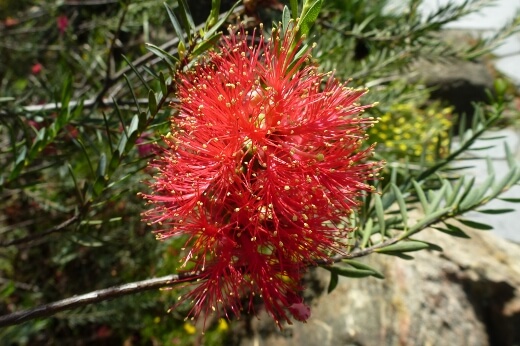
Watering Scarlet Honey Myrtle
In general, these plants enjoy quite a bit of moisture. It is recommended to water these plants well, especially at the time of planting. Although you can cut back quite significantly during the winter, if they're experiencing a dry spell, supplementary watering will be required.
It is also a reasonably drought-tolerant plant, so you won’t need to worry about your plants dying off should you forget to water them from time to time. Nonetheless, it is always best to stick to a regular watering routine.
Fertiliser
A general-purpose fertiliser can be added to the soil periodically. Fertiliser tends to be particularly effective when applied after flowering, supporting your scarlet honey myrtle during the colder seasons and encouraging new growth in the spring.
Pruning Melaleuca fulgens
Pruning can be done occasionally to help control shape and regulate size. It is not recommended to cut plants back too vigorously, as this may damage or remove next year’s flowering buds. A gentle prune every now and then should do the trick.
The showy flowers also make for wonderful cut flowers. As such, pruning can be done before all blooms are spent to make a beautiful, homemade bouquet.
Common Melaleuca fulgens Pests and Diseases
Although these plants are considered to be relatively pest-free, they can sometimes suffer from mealybug attacks. These can be spotted around and on the underside of leaves.
Simply treat by dipping a paintbrush into methylated spirits and running along with the leaves and stems. Diseases are also not common with these plants unless kept in unfavourable conditions and non-draining soil.
Keep a careful eye on soil conditions to ensure the soil is draining adequately between watering.
Melaleuca fulgens Frequently Asked Questions
What are other names for Melaleuca fulgens?
M. fulgens was first named as tea tree by Captain Cook when he landed in Australia, having brewed a fresh cup of tea from its leaves. The name stuck, and to this day it retains its name.
Also known as the Scarlet Honey Myrtle thanks to its fragrant blooms and vivid flower colour.
Is honey myrtle native to Australia?
M. fulgens, or scarlet honey myrtle is native to South Australia, Tasmania, and Victoria, and completely hardy when grown in gardens, and public parks throughout the country.
The foliage helps to deter pests and mosquitoes from the garden too and can be used to flavour food and water.
How do you grow Melaleuca fulgens?
M. fulgens grows best in full sun, but prefers some shade from the brightest afternoon sun, so should be planted just south of larger trees, or in slight shade from a wall.
They like good drainage, and are very drought tolerant, but if you can mulch the base when first planting, it will help to retain moisture and give the roots a head-start.
Is Myrtle a fire hazard?
The papery bark of myrtle trees catches quickly, and the oil-rich foliage burns fast and hot, potentially creating a fire hazard in gardens, so in warmer parts of the country, do not grow it within 15m of a house.
Why are Melaleuca fulgens called the paperbark tree?
The flaky, paper bark of M. fulgens gives it one of its many common names – the Paperbark Tree. The loose, peeling bark is incredibly attractive, and while it may present some problems, such as fire hazards, its ethereal beauty is unlike anything else you can grow.
Are Melaleuca fulgens roots invasive?
The roots of M. fulgens are not invasive, and will not cause significant damage to property or solid structures. However, they will spread by seed and can easily naturalise if left in a suitable habitat (and are now listed as invasive in Florida and parts of southern USA).
Do Melaleuca fulgens attract bees?
M. fulgens provides essential pollen for bees and other pollinators, and is a useful plant for any wildlife garden if you are planning on creating a sanctuary for nature in your own backyard.
Can you grow Melaleuca fulgens from cuttings?
Cuttings are an effective way to grow new M. fulgens. The Scarlet honey myrtle takes well from layered cuttings, and greenwood cuttings in spring, but requires some shade while the cuttings establish.
How long do Melaleuca fulgens live?
M. fulgens can live for over 100 years. By the time they are 40, they have a trunk circumference of nearly 3m and are resistant to high winds, drought, and flooding amongst other natural challenges.
How do you encourage myrtle to spread?
M. fulgens, or scarlet Myrtle, can be encouraged to spread by dividing the runners, and digging up volunteers that sprout around the base of the plant. Simply replant them about 3m apart and you’ll have happy healthy trees in no time.
Is Melaleuca fulgens poisonous to dogs?
M. fulgens is known to be topically toxic to dogs and cats. If ingested it will cause mild stomach upset and little else but should be avoided in high quantities either by ingestion or topically.

Start Growing Melaleuca fulgens Today
Be sure to sow seeds, plant and prune during the right time of year for absolute success. Melaleuca fulgens will make for an easily acquired flowering spectacle that will attract a range of beautiful wildlife to your garden.
Published on January 16, 2023 by Lorri Hopkins
Last Updated on February 22, 2024

